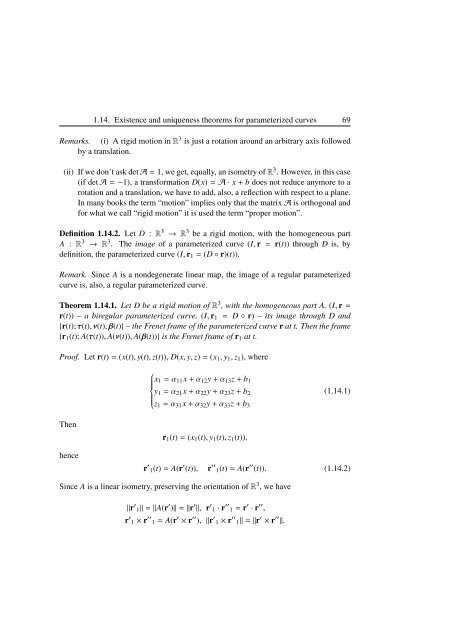Blaga P. Lectures on the differential geometry of - tiera.ru
Blaga P. Lectures on the differential geometry of - tiera.ru
Blaga P. Lectures on the differential geometry of - tiera.ru
You also want an ePaper? Increase the reach of your titles
YUMPU automatically turns print PDFs into web optimized ePapers that Google loves.
1.14. Existence and uniqueness <strong>the</strong>orems for parameterized curves 69<br />
Remarks. (i) A rigid moti<strong>on</strong> in R 3 is just a rotati<strong>on</strong> around an arbitrary axis followed<br />
by a translati<strong>on</strong>.<br />
(ii) If we d<strong>on</strong>’t ask det A = 1, we get, equally, an isometry <strong>of</strong> R 3 . However, in this case<br />
(if det A = −1), a transformati<strong>on</strong> D(x) = A · x + b does not reduce anymore to a<br />
rotati<strong>on</strong> and a translati<strong>on</strong>, we have to add, also, a reflecti<strong>on</strong> with respect to a plane.<br />
In many books <strong>the</strong> term “moti<strong>on</strong>” implies <strong>on</strong>ly that <strong>the</strong> matrix A is orthog<strong>on</strong>al and<br />
for what we call “rigid moti<strong>on</strong>” it is used <strong>the</strong> term “proper moti<strong>on</strong>”.<br />
Definiti<strong>on</strong> 1.14.2. Let D : R 3 → R 3 be a rigid moti<strong>on</strong>, with <strong>the</strong> homogeneous part<br />
A : R 3 → R 3 . The image <strong>of</strong> a parameterized curve (I, r = r(t)) through D is, by<br />
definiti<strong>on</strong>, <strong>the</strong> parameterized curve (I, r1 = (D ◦ r)(t)).<br />
Remark. Since A is a n<strong>on</strong>degenerate linear map, <strong>the</strong> image <strong>of</strong> a regular parameterized<br />
curve is, also, a regular parameterized curve.<br />
Theorem 1.14.1. Let D be a rigid moti<strong>on</strong> <strong>of</strong> R 3 , with <strong>the</strong> homogeneous part A, (I, r =<br />
r(t)) – a biregular parameterized curve, (I, r1 = D ◦ r) – its image through D and<br />
{r(t); τ(t), ν(t), β(t)} – <strong>the</strong> Frenet frame <strong>of</strong> <strong>the</strong> parameterized curve r at t. Then <strong>the</strong> frame<br />
{r1(t); A(τ(t)), A(ν(t)), A(β(t))} is <strong>the</strong> Frenet frame <strong>of</strong> r1 at t.<br />
Pro<strong>of</strong>. Let r(t) = (x(t), y(t), z(t)), D(x, y, z) = (x1, y1, z1), where<br />
Then<br />
hence<br />
⎧<br />
⎪⎨<br />
⎪⎩<br />
x1 = α11x + α12y + α13z + b1<br />
y1 = α21x + α22y + α23z + b2<br />
z1 = α31x + α32y + α33z + b3<br />
r1(t) = (x1(t), y1(t), z1(t)),<br />
(1.14.1)<br />
r ′ 1(t) = A(r ′ (t)), r ′′ 1(t) = A(r ′′ (t)). (1.14.2)<br />
Since A is a linear isometry, preserving <strong>the</strong> orientati<strong>on</strong> <strong>of</strong> R 3 , we have<br />
�r ′ 1� = �A(r ′ )� = �r ′ �, r ′ 1 · r ′′ 1 = r ′ · r ′′ ,<br />
r ′ 1 × r ′′ 1 = A(r ′ × r ′′ ), �r ′ 1 × r ′′ 1� = �r ′ × r ′′ �.












